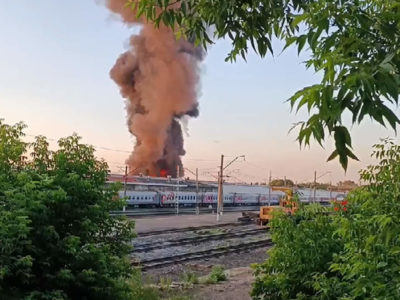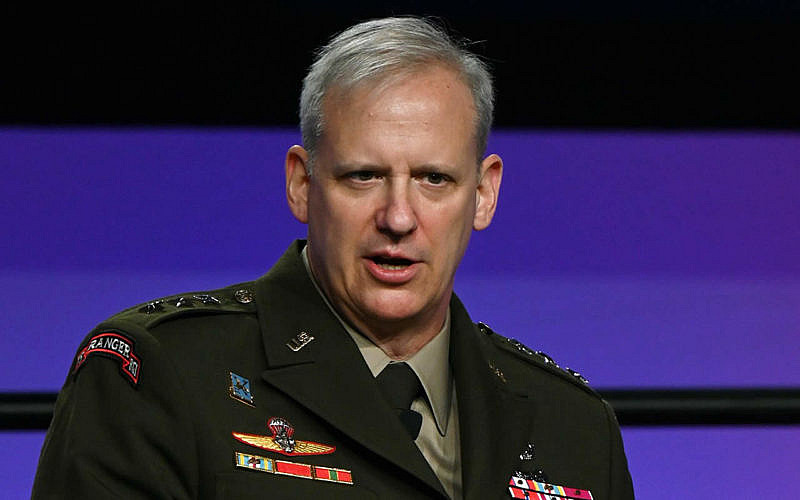
Not a day without sabotage. Every day in Russia something explodes and burns
Today is a vivid confirmation of the fact that sabotage, shelling, kamikaze drone attacks and large fires are taking place in Russia.

Perhaps Putin will use chemical, biological or nuclear weapons in view of the complexity of the military campaign.
There are many signs of how Ukraine has dashed Vladimir Putin’s hopes of a quick victory, and how the Russian military has proved far from ready for combat.
Trucks with Russian troops explode from rocket-propelled grenade launchers, foreign-made drones strike at Russian command posts.Orthodox priests in cassocks carry the blue and yellow flag of Ukraine, challenging their Russian invaders in occupied Berdyansk.
Russia has lost hundreds of tanks, many have been left burned or abandoned on the roads, and the death toll is nearing surpassing the death toll in Russia’s previous military campaigns.
Yet, after more than three weeks of war, when Putin’s original goal of easy regime change in Ukraine has long since faded, the Russian military is still strong.Military analysts warn that with more power and ammunition capable of razing any city to the ground, Russian troops could continue to fight on any plan putin approves, whether it’s a peaceful settlement or total destruction.
Despite all the determination of the people of Ukraine, all the casualties among the Russian troops and all the mistakes of the Russian leadership, there is no sign that the war will end soon.Even if Putin fails to bring Ukraine under control, he can continue punitive operations and destroy its cities.
Michael Clarke, the former head of Britain’s Royal Joint Institute for Defence Studies, said of Putin:
His instinct will tell him to double the stakes because he was getting into a terrible mess by making a huge strategic mistake.
And I don’t think it’s in his character to stop, he should keep moving forward.Putin’s troops in Ukraine are waging Russia’s largest and most complex military campaign since the capture of Berlin in 1945. His original goal, which he stated in a televised address on February 24, when the invasion began, was to “demilitarize” Ukraine and save its people. from “neo-Nazis,” a false description of a Ukrainian government run by a Jewish president.
Unfortunately, Putin underestimated the national pride and fighting skills that Ukrainians have accumulated over the past eight years as they fight Russian-backed separatists in the east of the country.
At first, the Russians thought that “they would install some pro-Russian government, finish the case and declare victory,” said Dmitry Gorenburg, a Russian security researcher at the CNA think tank in Virginia.”It was kind of a plan A, and as far as we can tell, they really didn’t have a plan B.”
Russia’s first obvious plan to strike at key Ukrainian military targets and quickly break through to Kiev immediately failed.He was hampered by the defense of Ukraine, as well as countless mistakes and organizational failures of the Russian military, which was told that it was mobilized only for the exercises.
Clark, a British researcher, described how the Russian military sold local residents communications equipment and fuel from military equipment for weeks as they waited on the border with Ukraine.
Lacking a friendly population to welcome them, Russian forces have reverted to the tactics of their past offensives in Syria and Chechnya — dropping bombs and firing rockets at cities, making millions of men, women and children refugees.
Putin’s troops are poised to seize the besieged port city of Mariupol.Overall, the Russians now appear to be fighting three goals: encircling Kiev, encircling the dispersed Armed Forces in the east and breaking through to the major port city of Odessa in the west, said Mikhail Kofman, a military expert. Russian Military and Program Director of CNA.
Kofman warns that much of the information about the war comes from Ukrainians, their American or other allies.This makes the partial image distorted and the full image impossible.
A senior U.S. Defense Department official on Friday said the Russians had launched more than 1,080 missiles since the war began because they had largely stalled across the country.The official said they retained about 90% of the combat power they placed around Ukraine at the start of the war.
The U.S. believes the airspace over Ukraine remains contested by the Ukrainian and Russian air forces, the official said on condition of anonymity when discussing military assessments.The Ukrainian Air Force continues to fly on aircraft and use air and missile defense.
“Just look at a map and you’ll see how little progress the Russians have made,” Pentagon spokesman John Kirby said recently.
Estimates of the killed Russians vary greatly.However, even the most conservative figures are in the thousands.This is a much faster rate of increase in casualties than in previous Russian offensives, threatening support for the war among ordinary Russians.
Russia lost 64 men in five days of fighting during the 2008 war with Georgia.It has lost about 15,000 people in Afghanistan in 10 years and more than 11,000 in years of fighting in Chechnya.
According to Gorenburg, the number of dead and wounded in Ukraine is approaching a 10 percent decline in combat capability.According to him, reports of the death on the battlefield of four Russian generals out of about 20 signal a deterioration in command.
Researchers who track only those losses of Russian equipment that were photographed or recorded on video say that Russia lost more than 1500 tanks, trucks, attachments and other heavy equipment.Two of the three pieces of equipment from them were captured or abandoned, which indicates the shortcomings of the Russian troops who abandoned them.
Meanwhile, Russia needs to limit the use of “smart” long-range missiles in case they are needed in any larger war with NATO, military analysts say.
According to analysts, when it comes to the painstaking work of capturing and holding cities, traditional military indicators suggest that Russia needs a 5-to-1 advantage in urban combat.
Meanwhile, the formula for managing a turbulent territory in the face of the armed opposition is 20 fighters for every 1,000 people or 800,000 Russian troops for more than 40 million people in Ukraine, Clark notes.That’s almost as much as Russia’s 900,000-strong active army.
On the ground, this means that controlling any significant swath of Ukrainian territory in the long run will require more resources than Russia could devote.
Moscow is demanding that Ukraine formally accept neutrality, thereby abandoning any alliance with NATO, and recognize the independence of the separatist regions in the east and Russia’s sovereignty over Crimea, which Russia annexed in 2014.
Russia’s other options include a relentless air campaign in which the Russian Air Force bombs and devastates cities, as it has done in Chechnya and Syria.U.S. officials have also warned of the risk of Russian chemical attacks and the threat of escalating into nuclear war.
“If the Russians are not going to stage a complete genocide — they can raze all the major cities to the ground, and the Ukrainians rise up against the Russian occupation — there will only be a constant guerrilla war,” Clark said.
Putin could threaten nuclear strikes if the war drags on.
Putin can be expected to threaten to use nuclear weapons against the West if stubborn Ukrainian resistance to the Russian invasion continues, draining conventional forces and equipment, according to a new assessment by the Pentagon’s intelligence agency.
The director of the U.S. Defense Intelligence Agency, Lt. Gen. Scott Berrier, said:
The prolonged occupation of part of Ukrainian territory threatens to lose russian military personnel and reduce their modernized arsenal of weapons, while subsequent economic sanctions are likely to plunge Russia into a protracted economic depression and diplomatic isolation.
The combination of Ukraine’s defiance and economic sanctions would jeopardize Russia’s ability to produce advanced precision-guided munitions.
As this war and its aftermath gradually weaken Russia’s conventional forces, Russia is likely to rely increasingly on its nuclear deterrent to signal to the West and project power onto its internal and external audiences.
The Pentagon agency’s gloomy assessment of the broader rates of war came on the eve of a conversation between President Joe Biden and Chinese President Xi Jinping. Even as U.S. officials struggle to understand China’s position on the war, Biden will seek help from Xi, increasing pressure on Moscow to end the war.
Putin has already announced that he has put Russia’s nuclear arsenal on high alert. The Russian Embassy in Washington did not immediately respond to a request for comment on the defense intelligence agency’s report.
The invasion has largely stalled as Russia is still counting on more than 1,000 long-range missile strikes on Ukraine.
U.S. efforts to thwart Russia’s plans in Ukraine, combined with its perception of the United States as a nation in decline, could prompt Russia to act more aggressively not only in Ukraine itself, but more broadly in its perceived confrontation with the West.
The motive for the invasion is Russia’s determination to restore a sphere of influence over Ukraine and other states of the former Soviet Union.
Despite Ukraine’s stronger-than-expected resistance and relatively high casualties in the initial stages of the conflict, Moscow appears determined to move forward using more lethal means until the Ukrainian government is ready to come to terms favorable to Moscow.
In addition to seeking to intimidate Russia’s adversaries, it reflects Moscow’s doctrine of using tactical, non-strategic nuclear weapons to coerce an adversary into negotiations that could lead to an end to the conflict on terms favorable to Russia, or deter an invasion by other actors when the course of an offensive by Russian conventional forces looks as if it could be reversed or the conflict dragged on.
As for conventional weapons, Russia’s failures in Ukraine still call into question Putin’s bluster about his military’s ability to deter or eliminate threats with fifth-generation fighter jets, advanced air and coastal defense missile systems, new surface ships, submarines, modern tanks, modernized artillery, and improved military command and logistics.
Based on:
Military.com and Bloomberg L.P
![]()